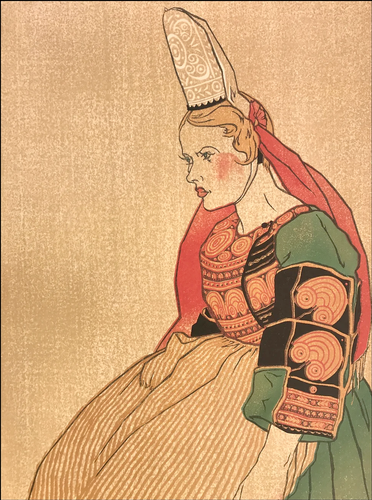
GEORGES GÉO-FOURRIER "THE SURVEYOR OF BRITTANY"
Share
I wanted to talk here about a real favorite of mine for the artist Géo-Fourrier.
I had made some allusions to his work previously on Instagram because the colors of his works are very inspiring coloramas.
I hope his work will amaze you as much as it does me.

This is a first small woodcut with gouache and stencil that literally captivated me some time ago. When I saw it, I spontaneously thought of Miyazaki's work. However, this drawing dates from the 1930s and represents a Breton woman from Douarnenez.
Where did this double cultural inspiration come from?

Géo-Fourrier, whose real name is Georges Nicolas Fourrier, is not Breton at all. He was born in Lyon in 1898 and grew up in Paris. His work includes engravings, paintings and illustrations. He uses a variety of plastic techniques that make his work original.
At the age of 16, he contracted a severe pneumonia that forced him to stay in bed for 3 years. Devoting this period to drawing and reading, Géo-Fourrier discovered and became passionate about Japanese arts.

This is why this influence is clearly perceptible in his prints and illustrations.
This love for Japan will push Géo-Fourrier to adopt a monogram as his signature where his intertwined initials G and F evoke a kanji, a type of Japanese character.

After training in wood engraving with the Japanese Urishibara and Prosper-Alphone Isaac, he entered the École Nationale des Arts Décoratifs in Paris in 1921 and became friends with Mathurin Méheut, Jean-Julien Lemordant, the folklorist Anatole Le Braz and the poet and novelist Charles Le Goffic.

It was through these friendships that he discovered the Bigouden country, in the years 1924-1926. From 1928, he settled there permanently because this land became his heartland. Until the end of his life, in 1966, he spent most of his time between Penmarc'h and Quimper.

At once an engraver, designer, book illustrator, decorator, photographer, ethnographer (also during stays in Africa) but also a ceramist, he collaborated with the Quimper earthenware factories including the Henriot earthenware factories from 1924 to 1950.

Géo-Fourrier devoted a significant part of his artistic life to representing, with an ethnologist's eye, the natives and landscapes of Brittany. It is the soul of a country that emerges from his work.

One of his favorite subjects that seems to fascinate him: the role and the female figure in Bigouden society. It is represented in a large number of drawings in the form of women with marked features, in a concern for realistic but sensitive aesthetics.

Faces imbued with a raw and unvarnished force, these women he represents are in festive costumes, at work or inscribed in the traditional Breton landscape. The artist liked to recall during his lifetime, about drawing: "Go to the essential, nothing but the essential, remove everything that is not essential."

Géo-Fourrier produced a huge number of postcards published by "Les Etablissements Artistiques Parisiens" which he sold in the small caravan he had built. It was at the foot of the Eckmühl lighthouse.


He died in Quimper in 1966, leaving behind a body of work that was little known to the public. Géo-Fourrier's recognition began with the spotlight on his work, thanks to collectors who worked for its recognition in the 1990s. But notably with the exhibition at the Pont-Aven Museum in 2002 and that of Pont L'Abbé in 2003. And most recently at the Forney Library in Paris in 2022.
Some of his works are currently kept at the Breton Museum in Quimper.

